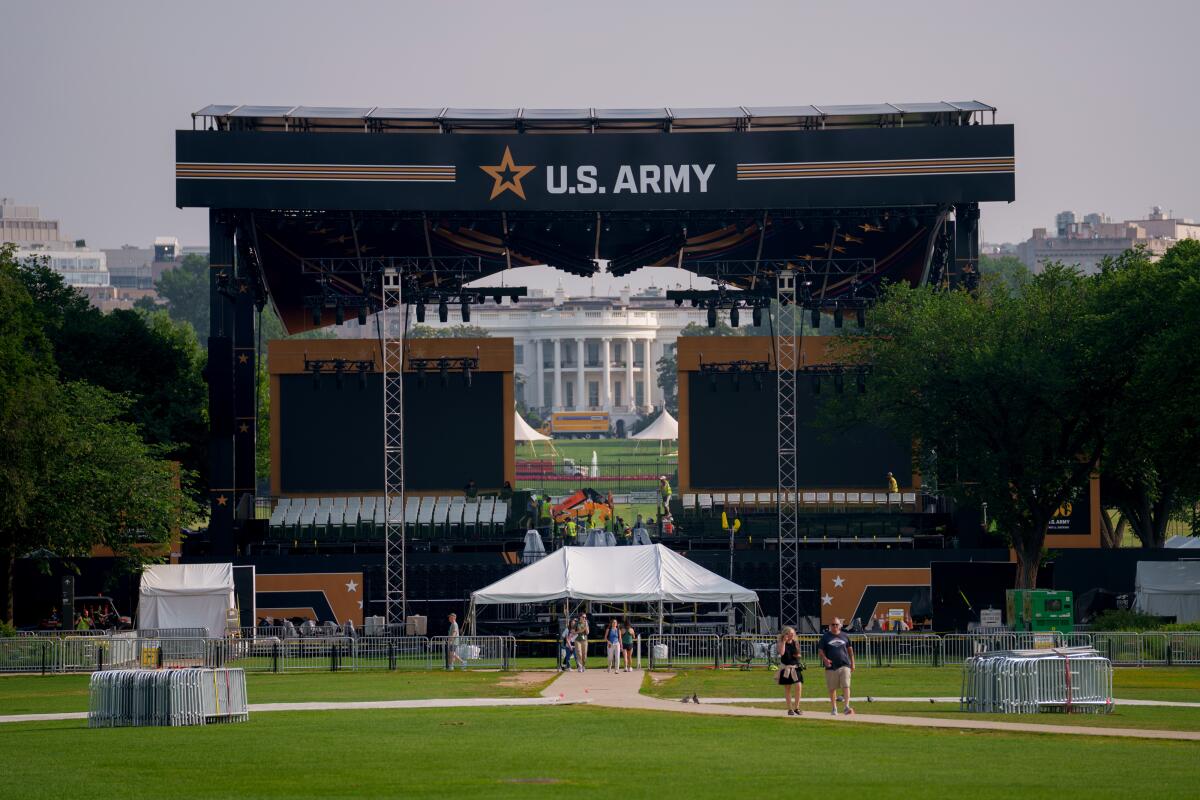WASHINGTON — Miles of fencing and concrete barriers lace the nation’s capital ahead of President Trump’s military parade along the National Mall on Saturday night — an event intended to celebrate the 250th anniversary of the founding of the U.S. Army, but which also coincides with the president’s birthday.
The event is expected to draw hundreds of thousands of attendees, the Secret Service said, drawn to the rare spectacle of military hardware and soldiers filing down American streets. It is an event that Trump has sought ever since his first term, when he fawned over the sight of a military march down the Champs-Élysées during a Bastille Day celebration in Paris. Trump’s event, according to an Army spokesperson, will cost between $25 million and $45 million, depending on how much damage the tanks inflict on D.C. roads.
Dozens of U.S. aircraft, hundreds of military vehicles, and thousands of soldiers are expected to take part in the parade, followed by a fireworks show. Both uniformed and plainclothes officers were seen practicing their march through the city on Friday morning. But the extent of Trump’s participation is not entirely clear in light of the emerging crisis in the Middle East between Israel and Iran.
While a handful of counter-protests are expected within the district itself, dozens are planned around the country. The “No Kings” protests, according to their organizers, are meant to counter-program Trump’s “made-for-TV display of dominance for his birthday.”
“Real power isn’t staged in Washington,” the group’s website reads. “It rises up everywhere else.”
The Trump administration has said it welcomes peaceful protests throughout the country on Saturday. But that White House commitment was called into question earlier this week, when a federal judge in California ruled that Trump had violated the law by federalizing the National Guard in response to largely peaceful demonstrations in Los Angeles protesting its immigration enforcement tactics.
In the ruling, U.S. District Judge Charles Breyer said he was “troubled by the implication” inherent in the Trump administration’s argument that “protest against the federal government, a core civil liberty protected by the First Amendment, can justify a finding of rebellion.”
Trump wrested control over the National Guard troops from California from Gov. Gavin Newsom to deploy 2,000 to Los Angeles after less than 24 hours of protests across the city.
Thousands more were later called to Los Angeles, as were hundreds of Marines.
Late Thursday, following an appeal by the administration, the U.S. 9th Circuit Court of Appeals put Breyer’s decision on hold, leaving the forces in L.A. under Trump’s control as the litigation continues.
A U.S. Army sign is positioned in front of the White House for Saturday’s parade.
(Eric Thayer / Bloomberg via Getty Images)
The deployments of troops to march in D.C. were not challenged, though critics of the current administration have similarly criticized their presence in an American city — blasting the parade as the sort of spectacle more expected from a country such as North Korea.
On Friday, downtown Washington was a maze of metal barriers surrounding monuments, museums and other landmarks such as the National Mall, where crowds are expected to gather beginning Saturday morning.
Constitution Avenue, where the parade will be held, was closed to traffic. Tourists wandered through openings in the gates, some lamenting the lengthy detours the barriers required — especially given the humidity and heat that pressed down on the city.
City road closures and flight delays from nearby Reagan National Airport are expected throughout much of Saturday. There is also a chance it will rain on the president’s parade, with thunderstorms, lightning and flash flooding forecast for the district. High chances of lightning, an Army spokesman said, could result in a cancellation of the festivities.
It was unclear to what extent protesters might target the parade itself. Trump has warned that “any” protesters at the event would be handled with “heavy force,” though the White House said that peaceful protests are fine.
Small signs of protest against the Trump administration were already apparent around the Mall Friday, though it was unclear when they’d been put up. One sign stuck to a utility box read, “Immigrants are not the enemy,” while another read, “All You Fascists Bound to Lose.”
A man road a bicycle along 14th Street near the Washington Monument holding up a large sign calling the president a “creep” and “unfit” — among other things.
The security measures were similar to those put in place during other major events in Washington’s downtown core — at least since Trump’s supporters stormed the U.S. Capitol on Jan. 6, 2021, in a failed attempt to keep Trump in office after his 2020 loss to President Biden.
The insurrection caused widespread damage to the Capitol and put many lawmakers at risk, but drew a decidedly different response from Trump than the recent protests in L.A. Shortly after he was reelected, Trump pardoned all of the Jan. 6 insurrectionists.
